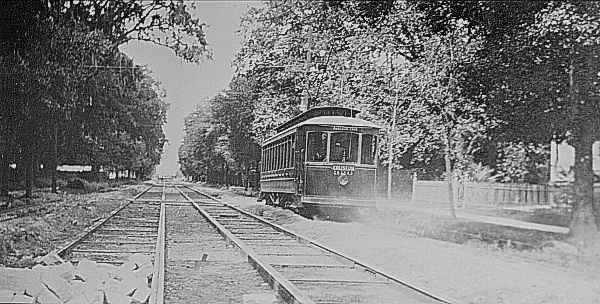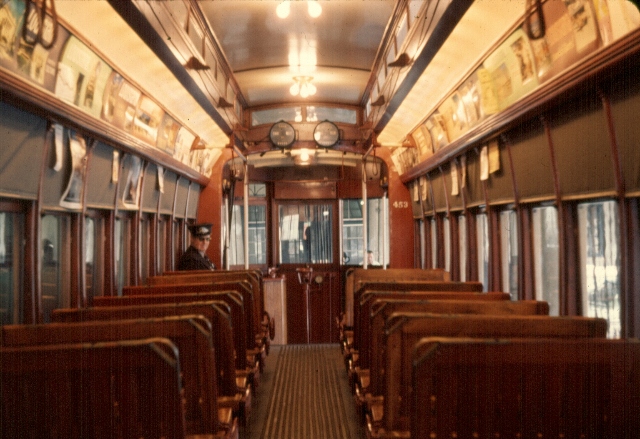



By 1960s, operators trained on 900s. 453 moved to Carrollton Station in 1964 for complete RB, but w/o semi-convertible feature restored. In fact, the trac. mot. (Whse. 306-CV-4) were replaced by wooden facsimile, along with other components, so the car would be a non-operating static exhibit. At first the plan called for the car to tour the U. S. on a flat-bed with advertising people boosting N. O. as tourist attraction. This plan collapsed and in 1967 the car moved to a semi-protected place behind the Morning Call Coffee House, open to the public as “Streetcar Named Desire” complete with brass plaque explaining the car's history (although no evidence a semi-convertible ever served the Desire Line). 453 was a satellite office of the Louisiana Tourist Commission with a state employee as “motorman” to greet all visitors — and there were many. At least two postcards were made for the car, and it seemed 453's future was assured. Then came a big problem: one of too many, so many, of historic New Orleans disastrous “rebuildings” — a hare brained idea to move the Morning Call and as many other attractions that the French Market had offered for over 200 years — to Jefferson Parish's N. O. suburbs! The plan collapsed but not before 453 was moved into the full fury of the weather's ruinous elements, in 1973 — to languish at the rear of the renovated French Market. After vandals had done with the car, it was moved across the iron fence beside the U. S. Mint. 453 received a cosmetic paint job which did slow down the weather damage. About 1990, RTA rescued 453, moving it to a new barn, a small structure, at Napoleon Station (Yard) which was a maint. shop for Riverfront cars. When the physical connection on Canal St. was built between the St. Charles and Riverfront Lines (and the Riverfront was RB to 5'2½"), 453 was moved to Carrollton Station for secure inside storage.
Hopefully, this treasure, now 99 years old, will be restored to its original authentic status as a fully operating semi-convertible.
| SERVICE RECORD | ||||
| 300 | COL 3/11/12 | 314 | MG 2/11/14 | |
| 301 | COL 2/5/07, 8/1/07 | 315 | COL 11/27/06, 12/7/06, MG 3/13/07, 10/4/13, 4/18/21 | |
| 303 | COL 2/12/09, 10/4/10, LO 3/27/19 | 317 | COL 1/13/10, 1/21/10, MG 10/13/18, 11/26/18 | |
| 304 | COL 7/7/06, 4/16/12, 5/27/12 | 319 | COL 8/2/07 | |
| 305 | MG 1/14/15 | 320 | MG 10/1/13, 7/23/20 | |
| 306 | COL 11/29/10, LO 3/21/18, PR 1/15/21 | 321 | COL 2/7/07 | |
| 308 | LO 12/18/15, 7/8/18, 1/25/19 | 322 | COL 8/9/06 | |
| 309 | COL 6/29/06, 11/19/06, 10/23/09, 11/17/12, 3/22/13 | 323 | COL 10/30/12 | |
| 310 | COL 3/11/07, 9/21/08 | 324 | COL 7/29/07, 3/28/12 | |
| 311 | COL 2/8/08, 6/2/08, 7/20/08 | |||
| 312 | COL 12/13/10, MG 9/28/14 | 462 | DR 11/17/24 | |
| 313 | COL 9/10/12 | 467 | MG 12/12/21 | |
 |
Semiconvertibles 300 and 320, signed for the Coliseum line, pass along a temporary track through Audubon Park. At this time (before August 12, 1913), Coliseum cars ran along upper Magazine Street, through Audubon Park, out Broadway, ultimately wandering out to the Protection Levee at Southport. The construction in progress here was probably the moving of the tracks through Audubon Park to the side of the road. — D. R. Toye, S. J. collection, Kenner Train Shop (Chris Rodriguez) collection, courtesy of Mike Palmieri |
 | |
 |
Surviving car 453, about 1970, when it was on display in the French Market. The interior changes can be seen by comparing to the builder's photo on the previous page. One particularly obvious change is that the interior bulkheads and doors have been removed. The “motorman” is Byron Pulley. — Earl Hampton photo |
 |
Car 453 on November 24, 2009, in storage at Carrollton Station. RTA reports no plans for its future. Note the complete absence of markings except for the stripe around the dash. Even the car number is missing. — Earl Hampton photo |
| DTAR | 400-449 | 34'8" OB 47'8" OA 6'2" PL. 11'3 5/8" HT 8'7" W |
39-E-1 4'10" WB 30" & 21" WH | Southern Car Co. | ON —— | 50 cars all 4'8½" |
| (Truck order) Brill ON 19442 3 July 14 Promised 15 Oct. 100 trucks (less WH) | ||||||
| “Thru United Gas & Elec. Engineering Corp.” “For N. O. Ry. & Lt. Co.” | ||||||
| President Pevear of NORy&LtCo announced (DP 12/5/14)
“Fifty cars expected soon...First to arrive next week, four cars...then five
per week will arrive. Modern cars of the Chicago type.”
The cars will replace “all small cars” on St. Charles-Tulane Belts (DP 1/26/15).
“Chicago type” designed by H. H. Adams, Supt. Shop & Equip., Chicago Rys. Southern Car Co. BLT 50 underframes for these cars. Completed, the Chicago cars each weighed 35,358#, were 32'5" OB, 48'5" OA, seated 48 (about 763# per seated rider). See ERJ v. XLII no. 6 pp. 230-232 8/9/13 and subsequent ERJ coverage. UG&EE Corp. approached Perley A. Thomas, Engr.-Design of Sou. Car Co., requesting a design for a comparable car, DTAR light, fast, substantial construction. The 400s were the result. ERJ v. XLV no. 6 pp. 270-274 2/6/15 announced the 400s “a new design...a radical departure...almost all steel, only the roof sheathing and floor being of wood.” WT 36,100#, seats for 52, only 674# per seated rider. In fact, there was less wood in the 400s than in the 800s, 900s or 1000s. Continuous post principle used, adopted about three years earlier by Charles O. Birney of Stone & Webster. NOPSI total WT slightly higher, see S p. 149. As deliv. P - S p. 150, with Herr fenders. Olive green color, standard in N. O. since consolidation of all ry. corps. 1902. Light roof color in late 30s for short time (several P - S). By then Providence Lifeguard fenders had repl. the Herrs. S p. 150, lg. P - S pp. 147-48. Scale drawing p. 149. Brill order claims 39-E but P evidence shows 39-E-1. RG program could have begun by 1925, but surely by 1929, Oct. at latest. RG Jackson Line 10/28/25, North Claiborne 2/21/26, Oak St. Shuttle abandoned 7/2/29, and last 4'8½" lines RG, St. Charles-Tulane Belts, night of Oct. 2-3, 1929, between rush hours! The 400s body hung low as poss. over the 30" WH. First step 13 5/8" from rail level. Second step to platform 11" and a 7¾" step up to floor level — a ramp of 3¼" extends fm. end sill to bolster. Total HT floor level to rail: 35 5/8". Burdette-Roundtree mechanisms connect step movement with sliding doors — only cars in N. O. thus equipped. Stanchions and hang strap tubing are enameled. Furnished by Ellcon Co. Car posts “unique” (ERJ). No. 16 ga. steel plate pressed into “U” shape, flanges securely riveted to the side girder. Carlines also pressed “U” sections riveted & bolted to top of posts, fitting inside posts thus forming continuous member from one side of car to other. Corner posts deep “U” shape. Vestibule posts also pressed steel. The 400s had car destination roll sign boxes on each side, but removed early, perhaps before 1930. P - N. The 400s carried ad signs on the L. H. side of the dash, while all other Thomas cars did so on the R. H. side. |
||||||
Text copyright © 2008 Louis C. Hennick. Pictures copyright © 2009, 2010 by the persons credited. Picture captions copyright © 2009, 2010 Louis C. Hennick and H. George Friedman, Jr. All rights reserved.
Computer Science Department, University of Illinois at Urbana-Champaign, Home Page